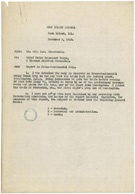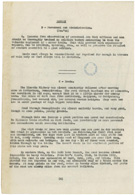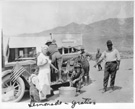America on the Move
Lt. Col. Dwight D. Eisenhower - Transcontinental Motor Convoy, 1919
At the end of World War I, in which vehicles played a vital role, the U.S. War Department wanted to know if the country’s roads could handle long-distance emergency movements of motorized army units across the nation. As a test, the Transcontinental Motor Convoy—some 80 military vehicles and 280 officers and enlisted personnel—set out for California from Washington, DC, on July 7, 1919.
In the manner of the wilderness scouts of the nineteenth century, army personnel mounted on Harley-Davidsons instead of horses, would run ahead of the convoy to check out the conditions that lay just ahead. The vehicles broke down, got stuck in dust, quicksand, and mud, and sank when roads and bridges collapsed under them. Sixty-two days after it left Washington, DC, the convoy reached San Francisco. It had covered 3,251 miles, averaging 58 miles a day at an average speed of 6 miles an hour. The official report of the War Department, chronicling the 230 motor accidents of the convoy, concluded that the existing roads in the United States were “absolutely incapable of meeting the present day traffic requirements.”
One of the army observers on the convoy was Armored Corps representative, Lt. Col. Dwight D. Eisenhower, a 28-year-old officer grown bored with his peacetime posting at Fort Meade. His summary report is presented here.
Lt. Col. Dwight D. Eisenhower’s summary report on the Transcontinental Motor Convoy, November 3, 1919, cover memo
The convoy made its way west via the Lincoln Highway (now U.S. 30), passing through some 350 towns. Half of the distance traveled was over dirt roads, wheel paths, desert sands, and mountain trails. Eisenhower later said the roads they encountered “varied from average to non-existent.”
National Archives, Dwight D. Eisenhower Presidential Library and Museum, Abilene, Kansas
.
Lt. Col. Dwight D. Eisenhower’s summary report on the Transcontinental Motor Convoy, November 3, 1919, page 4
The convoy made its way west via the Lincoln Highway (now U.S. 30), passing through some 350 towns. Half of the distance traveled was over dirt roads, wheel paths, desert sands, and mountain trails. Eisenhower later said the roads they encountered “varied from average to non-existent.”
National Archives, Dwight D. Eisenhower Presidential Library and Museum, Abilene, Kansas
Excerpt:
“In Illinois [the convoy] started on dirt roads, and practically no more pavement was encountered until reaching California.”
—From Lt. Col. Dwight D. Eisenhower's Report
.
Lt. Col. Dwight D. Eisenhower, 1919
The experience, which Eisenhower later described as “a genuine adventure” left a lifelong impression on him. Thirty-seven years later, as President of the United States, Eisenhower signed into law the Federal-Aid Highway Act of 1956, funding the National System of Interstate and Defense Highways which established more than 41,000 miles of superhighway.
National Archives, Dwight D. Eisenhower Presidential Library and Museum, Abilene, Kansas [NLDDE-62-286-2]
.
“Lemonade—gratis,” 1919
Although the convoy was intended to be self-sustaining to simulate wartime conditions, this goal was undermined by the barbecues, melon fests, and other offerings of the hospitable Americans who welcomed the convoy to their towns.
Dwight D. Eisenhower annotated this photograph.
National Archives, Eisenhower Presidential Library and Museum, Abilene, Kansas [NLDDE-81-17-51]
.



